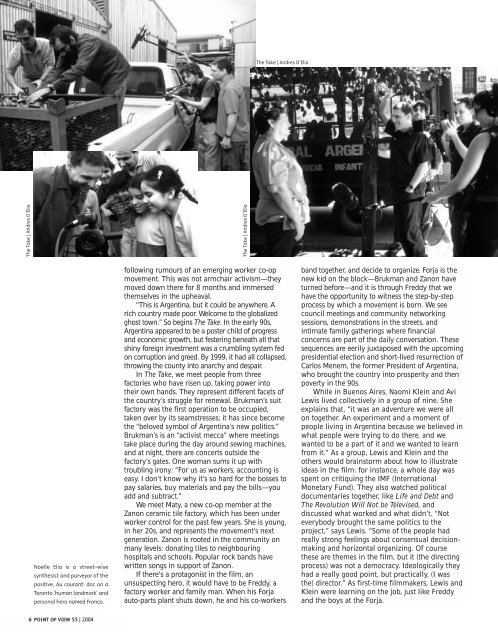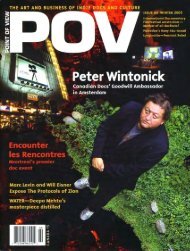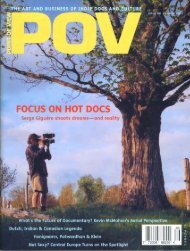Into the Heart of Resistance
Into the Heart of Resistance
Into the Heart of Resistance
You also want an ePaper? Increase the reach of your titles
YUMPU automatically turns print PDFs into web optimized ePapers that Google loves.
The Take | Andres D’Elia<br />
The Take | Andres D’Elia<br />
The Take | Andres D’Elia<br />
Noelle Elia is a street-wise<br />
syn<strong>the</strong>sist and purveyor <strong>of</strong> <strong>the</strong><br />
positive. Au courant: doc on a<br />
Toronto 'human landmark' and<br />
personal hero named Franco.<br />
following rumours <strong>of</strong> an emerging worker co-op<br />
movement. This was not armchair activism—<strong>the</strong>y<br />
moved down <strong>the</strong>re for 8 months and immersed<br />
<strong>the</strong>mselves in <strong>the</strong> upheaval.<br />
“This is Argentina, but it could be anywhere. A<br />
rich country made poor. Welcome to <strong>the</strong> globalized<br />
ghost town.” So begins The Take. In <strong>the</strong> early 90s,<br />
Argentina appeared to be a poster child <strong>of</strong> progress<br />
and economic growth, but festering beneath all that<br />
shiny foreign investment was a crumbling system fed<br />
on corruption and greed. By 1999, it had all collapsed,<br />
throwing <strong>the</strong> county into anarchy and despair.<br />
In The Take, we meet people from three<br />
factories who have risen up, taking power into<br />
<strong>the</strong>ir own hands. They represent different facets <strong>of</strong><br />
<strong>the</strong> country’s struggle for renewal. Brukman’s suit<br />
factory was <strong>the</strong> first operation to be occupied,<br />
taken over by its seamstresses; it has since become<br />
<strong>the</strong> “beloved symbol <strong>of</strong> Argentina’s new politics.”<br />
Brukman’s is an “activist mecca” where meetings<br />
take place during <strong>the</strong> day around sewing machines,<br />
and at night, <strong>the</strong>re are concerts outside <strong>the</strong><br />
factory’s gates. One woman sums it up with<br />
troubling irony: “For us as workers, accounting is<br />
easy. I don’t know why it’s so hard for <strong>the</strong> bosses to<br />
pay salaries, buy materials and pay <strong>the</strong> bills—you<br />
add and subtract.”<br />
We meet Maty, a new co-op member at <strong>the</strong><br />
Zanon ceramic tile factory, which has been under<br />
worker control for <strong>the</strong> past few years. She is young,<br />
in her 20s, and represents <strong>the</strong> movement’s next<br />
generation. Zanon is rooted in <strong>the</strong> community on<br />
many levels: donating tiles to neighbouring<br />
hospitals and schools. Popular rock bands have<br />
written songs in support <strong>of</strong> Zanon.<br />
If <strong>the</strong>re's a protagonist in <strong>the</strong> film, an<br />
unsuspecting hero, it would have to be Freddy, a<br />
factory worker and family man. When his Forja<br />
auto-parts plant shuts down, he and his co-workers<br />
band toge<strong>the</strong>r, and decide to organize. Forja is <strong>the</strong><br />
new kid on <strong>the</strong> block—Brukman and Zanon have<br />
turned before—and it is through Freddy that we<br />
have <strong>the</strong> opportunity to witness <strong>the</strong> step-by-step<br />
process by which a movement is born. We see<br />
council meetings and community networking<br />
sessions, demonstrations in <strong>the</strong> streets, and<br />
intimate family ga<strong>the</strong>rings where financial<br />
concerns are part <strong>of</strong> <strong>the</strong> daily conversation. These<br />
sequences are eerily juxtaposed with <strong>the</strong> upcoming<br />
presidential election and short-lived resurrection <strong>of</strong><br />
Carlos Menem, <strong>the</strong> former President <strong>of</strong> Argentina,<br />
who brought <strong>the</strong> country into prosperity and <strong>the</strong>n<br />
poverty in <strong>the</strong> 90s.<br />
While in Buenos Aires, Naomi Klein and Avi<br />
Lewis lived collectively in a group <strong>of</strong> nine. She<br />
explains that, “it was an adventure we were all<br />
on toge<strong>the</strong>r. An experiment and a moment <strong>of</strong><br />
people living in Argentina because we believed in<br />
what people were trying to do <strong>the</strong>re, and we<br />
wanted to be a part <strong>of</strong> it and we wanted to learn<br />
from it.” As a group, Lewis and Klein and <strong>the</strong><br />
o<strong>the</strong>rs would brainstorm about how to illustrate<br />
ideas in <strong>the</strong> film: for instance, a whole day was<br />
spent on critiquing <strong>the</strong> IMF (International<br />
Monetary Fund). They also watched political<br />
documentaries toge<strong>the</strong>r, like Life and Debt and<br />
The Revolution Will Not be Televised, and<br />
discussed what worked and what didn’t. “Not<br />
everybody brought <strong>the</strong> same politics to <strong>the</strong><br />
project,” says Lewis. “Some <strong>of</strong> <strong>the</strong> people had<br />
really strong feelings about consensual decisionmaking<br />
and horizontal organizing. Of course<br />
<strong>the</strong>se are <strong>the</strong>mes in <strong>the</strong> film, but it (<strong>the</strong> directing<br />
process) was not a democracy. Ideologically <strong>the</strong>y<br />
had a really good point, but practically, (I was<br />
<strong>the</strong>) director.” As first-time filmmakers, Lewis and<br />
Klein were learning on <strong>the</strong> job, just like Freddy<br />
and <strong>the</strong> boys at <strong>the</strong> Forja.<br />
6POINT OF VIEW 55 | 2004




